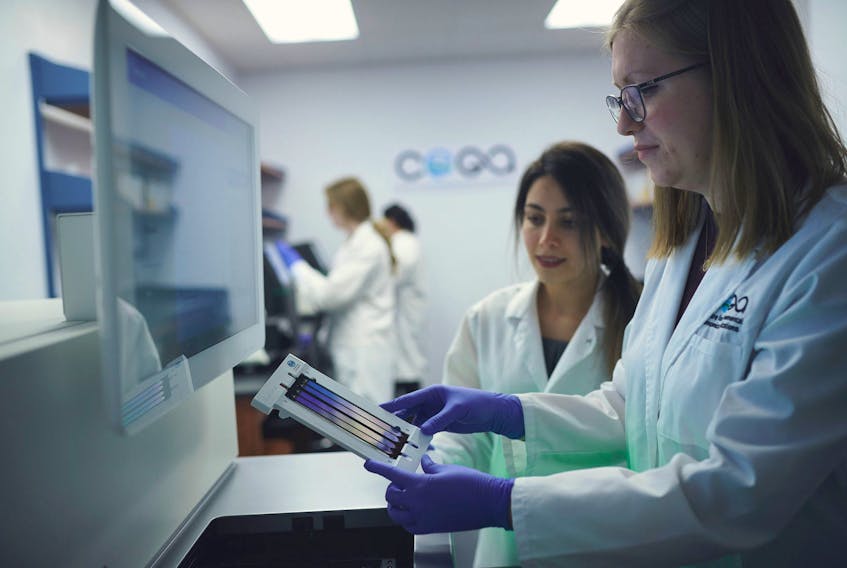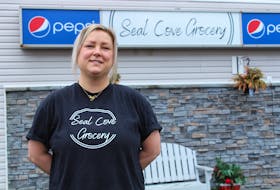It’s just a litre of seawater.
But it holds a massive amount of DNA, biological information that could help scientists gain more knowledge about the Labrador Sea and other deep-sea environments.
Dr. Greg Singer is an expert in bioinformatics and Chief Technology Specialist at eDNAtec, a St. John’s based company that has developed technology and processes to examine biodiversity in ocean environments.
Working with the Department of Fisheries and Oceans (DFO) the company has been collecting Labrador seawater samples to determine the biodiversity there.
A one-litre sample collected from the Labrador Sea last year, for instance, showed the presence of about 10,000 species, Singer told SaltWire.

The company has been working in collaboration with DFO and Memorial University’s Marine Institute, since 2018, and just this week published the results of a collaborative study.
The study of the biodiversity of the Labrador Sea is very new.
In fact, the work being done by eDNAtech and the DFO is the first time anyone has tried to determine how many and what kind of species live in that part of the ocean.
David Cote is a research scientist with the DFO.
In an interview with SaltWire he said the world’s deep oceans are the most under-studied environments in the world.
“And the Labrador Sea is particularly interesting because it’s a globally-important part of the ocean.
“There’s downwelling that takes water from the surface and things like atmospheric carbon and oxygen and brings it down to the deep ocean.
“That current also drives climate patterns around the world as well.”
Oceanographers have been working in the Labrador Sea for a long time, he said, and have a built up a good collection of data.
However, scientists did not have a lot of information about all the marine life in the Labrador Sea.
“It’s a complete frontier area we’re working in,” he said.
Conventional methods of sampling — tow nets or hook-and-line fishing to collect samples of marine life, or remotely operated vehicles to capture images below the sea — can only provide information on species that are large enough to see or catch.
Traditional survey methods don’t provide information to show the biodiversity of that marine region.
Then there’s the weather factor of the Labrador Sea, an environment that makes it more challenging to schedule sea time for research vessels and limits the amount of time scientists can spend collecting samples.
The technology

Dr. Mehrdad Hajibabaei, founder and Chief Scientific Officer with eDNAtec, said in a news release the findings of that report show the eDNA technology has great potential for monitoring the full abundance of fish populations in such a challenging environmental setting.
“It proved our technology is able to detect more species than a combination of trawling, baited cameras, and acoustics, providing faster, safer, and more comprehensive results with only a fraction of the ship time and labour.”
The Labrador Sea is not the first aquatic environment to use this science.
Dr. Singer said Dr. Hajibabaei, is working with Environment Canada and citizen scientists to collect water from rivers and lakes around the country to measure the health of those ecosystems.
“The nice thing about this DNA technique is that it’s quite easy, it's just collecting water … and it’s quite cheap.”
Singer added the collection of water samples in the open ocean is a bit trickier, due to weather and water depths, but other people could eventually help in that collection.
“We sort of envision a future where …. shipping vessels or fishing vessels, as they are out there doing what they do they could be collecting water samples from the ocean. And we could analyze those to find what’s living in an area at a certain time, to create a better map of what’s living where and at what time of the year.”
The neat thing about this science, said Singer, is that they only need a small water sample for analysis.
In the first year of their research in the Labrador Sea, he said, they analyzed just half a litre of water.
In the second year they sampled about 1.5 litres.

And samples can be frozen, for other science assessments at a later date, he added.
“In a freezer, the DNA actually lasts forever. And there may come a time, years down the road, where we might want to go back to re-analyze the samples to gather other information.”
The knowledge base that can be built is limited only by the amount of water samples that can be collected.
Singer said the machine used by eDNAtec can analyze 48 genomes in a couple of days; that’s considered to be rapid results in the realm of DNA analysis.
“Our machine is nowhere near maximum capacity,” he told SaltWire.
They’d like to keep it busy.
“We’d really welcome getting more samples so we could create a really dense map of offshore Newfoundland and Labrador, and from various time points too. It would be really interesting to see how things look in January, compared to August.”
A continuous flow of samples and data year after year, he added, could build a big picture on the effects of climate change, and how warming waters may be changing up the types of species in a marine region.
Extra tool for scientists

Cote considers the genome research and eDNAtec lab to be another tool in the DFO science arsenal and to create a better understanding picture of the deep ocean.
“It’s a way that we can not only save a lot of time and money but capture a much broader swath of the ecosystem.
“For instance, if we do a hook and line fishery to figure out what kind of fish are there, we are only capturing the fish that are large enough to bite the hook. But we were missing other fish species that are there, not to mention all the organisms — from plankton to corals and sponges and all the way up to whales.”
Cote said water samples and DNA testing won’t entirely replace conventional methods used to determine species abundance, but it will be useful to show the presence or absence of the variety of species in a particular region.
“It will be very useful for biodiversity assessments and determining (marine) areas that you might want to protect,” said Cote.
“It’s a powerful tool that we can use for parts of our work and possibly complement other methods we use for things like stock assessments.”









